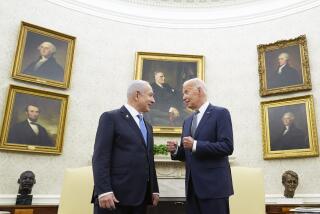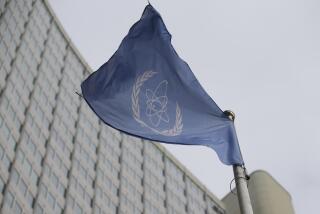Iran Hiding Its Nuclear Activities, Report Says
ISTANBUL, Turkey — Senior Iranian officials are overseeing efforts to conceal key elements of the country’s nuclear program from international inspectors, according to Western diplomats and an intelligence report.
If the cover-up is confirmed, it would bolster the U.S. assertion that Iran is trying to hide a secret nuclear weapons program.
Iran set up a committee late last year to coordinate the concealment efforts after international inspectors uncovered evidence that the Islamic Republic had tried to hide aspects of its nuclear program, including secret research on advanced centrifuges that can produce weapons-grade uranium, according to the diplomats.
A diplomat, who spoke on condition of anonymity, said the committee’s most pressing tasks include trying to hide nuclear evidence at nearly 300 locations around the country. The committee is said to be composed mainly of senior officials of the Atomic Energy Organization of Iran who report to high-ranking government officials.
Iran has said that it will deny access to some suspect sites by international inspectors, who are scheduled to continue their work today. Iran cited a continuing New Year holiday as justification for barring the inspectors.
A Bush administration official said the United States had received the intelligence report -- prepared by a country other than the United States -- within the last month and believes it to be credible.
Washington would probably portray any Iranian cover-up as smoking-gun evidence of a nuclear weapons program. The U.S. is likely to use any such evidence to prod the Europeans, who have been pursuing an engagement strategy with Tehran, to take a harder line at the June meeting in Vienna of the U.N. nuclear watchdog, the International Atomic Energy Agency, or IAEA.
“The report is being viewed seriously because it originates from outside U.S. intelligence sources,” said the U.S. official, who spoke on condition of anonymity. “It has contributed to a greater sense of frustration, both in the U.S. and within the IAEA.”
The Western diplomat who first described the new intelligence report is not American. He also provided a written analysis of the report to The Times, but not the actual document.
“The [Iranian] committee is making a thorough and systematic examination of all uranium conversion facilities, centrifuge component manufacturing plants and other secret installations to locate poor concealment,” the analysis read. “It will then order improved concealment measures with a view to making them hermetic before inspections resume.”
IAEA inspectors already have discovered elaborate efforts by Iranian authorities to conceal nuclear activities in recent months. At one site near Tehran, workers completely renovated a workshop in an unsuccessful attempt to hide evidence of uranium enrichment, according to an IAEA report. On March 13, the 35 countries on the IAEA board condemned Iran for withholding sensitive information from inspectors. Iran retaliated by immediately suspending inspections of its nuclear facilities, accusing the board of buckling under U.S. pressure.
After negotiations with the nuclear watchdog, Iran agreed to allow inspectors to return today. But a diplomat involved in the process said Tehran was only allowing the team to visit locations previously identified as nuclear installations.
Tehran, the diplomat said, is claiming that a clause in the agreement with the IAEA allows it to block additional inspections during holidays.
“They said New Year’s celebrations are continuing until sometime in April,” said the diplomat, who spoke on condition of anonymity.
“There’s nothing in the additional protocol that says you can’t inspect on holidays,” countered a second U.S. official who is involved with the Iranian nuclear issue. “The holiday is an excuse by Iran to cover up something.”
The anticipated delay makes it unlikely that the IAEA will have time to prepare a complete report on Iran’s compliance with its disclosure requirements in time for the next scheduled agency board meeting in June, according to people familiar with the process.
The intelligence report, which was prepared before Iran suspended inspections, said that the concealment committee was “formulating a contingency plan: thinking up reasons for delaying the inspectors’ return to Iran, if it becomes necessary,” according to the written analysis.
A second foreign diplomat confirmed the substance of the report’s central allegations about a focused effort by Iran to hide nuclear activities. The diplomat said there was independent evidence that Iran was still concealing some nuclear sites, adding that the IAEA learned of the committee’s existence late last year.
Pirooz Hosseini, Iran’s ambassador to the IAEA, said in a telephone interview Friday that charges of a cover-up were “totally baseless” and that Iran had disclosed all of its nuclear activities.
“We have adopted a policy of full transparency, and we have declared all of our nuclear activities to the IAEA,” Hosseini said.
Iran has said its program is strictly intended to generate electricity, but a series of inspections by the IAEA over the last year has turned up evidence that the U.S. says points to a weapons program.
Among the most troubling disclosures were the discovery of traces of weapons-grade uranium at two locations and Iran’s failure to disclose that it had received centrifuge designs supplied by Abdul Qadeer Khan, the Pakistani scientist who operated a black market in nuclear technology.
Mohamed ElBaradei, the director-general of the IAEA, is scheduled to visit Tehran early next month to tell Iranian officials that they must disclose everything related to the country’s nuclear program.
The IAEA declined to comment on ElBaradei’s trip or the allegations that Iran was involved in a cover-up.
The inspection team in Iran now is expected to visit a plant being built near Esfahan to produce uranium hexafluoride, which is used to fuel centrifuges that enrich uranium. The Iranians have said that the conversion plant was part of the civilian effort and that it has not become operational.
But the intelligence report said that nuclear materials had been brought to the plant and it was started up in late February without notification to the IAEA, as required by regulations.
“The dilemma facing the committee and Esfahan officials is how to conceal, post facto, the introduction of natural uranium from unknown sources, which apparently was undeclared,” said the analysis of the report.
Hosseini, the Iranian ambassador, said that there was no enrichment activity at the Esfahan plant and that it was still under full IAEA supervision.
The United States is opposed to the Esfahan plant on the grounds that it would give Iran the ability to perfect technology for a full nuclear fuel cycle. That technology could be replicated for military purposes.
In Washington, the Central Intelligence Agency and the National Security Council declined to comment on any intelligence. A senior administration official said only that “we would not find it entirely surprising, given Iran’s pattern of deception.”
While insisting that Iran is violating its promises to cease all nuclear enrichment and cooperate with the IAEA, the Bush administration has softened its stance in an attempt to forge a united front with the Europeans. Britain, France and Germany have crafted a policy that would eventually give Iran trade concessions in exchange for compliance with the IAEA.
The three allies rejected a U.S. bid in November to persuade the IAEA to refer Iran’s nuclear activities to the U.N. Security Council for possible condemnation.
A German Embassy spokesperson said the German government would wait until the next IAEA report, scheduled for May, is released before making any decisions.
The administration now appears to be playing it uncharacteristically cool, waiting quietly in hopes that evidence of concealment will mount.
The strategy aims at prompting ElBaradei and the Europeans to take the lead in demanding compliance from Tehran.
The United States cannot hope to command a majority vote from the IAEA Board of Governors without the Europeans, but an IAEA tradition of unanimous board decisions makes it even more important to build a broad-based consensus.
Henry Sokolski, executive director of the Nonproliferation Policy Education Center in Washington, said Iran was being treated softly because of fears among IAEA member countries that aggressive action would be seen as inspired solely by Washington.
“The nonaligned movement is viewing any enforcement of the rules as being driven by the hidden hand of Uncle Sam, and as a result, if any country raises this they are a tool of the U.S. and they’re dismissed,” Sokolski said.
*
Frantz reported from Istanbul and Efron from Washington.
More to Read
Sign up for Essential California
The most important California stories and recommendations in your inbox every morning.
You may occasionally receive promotional content from the Los Angeles Times.









